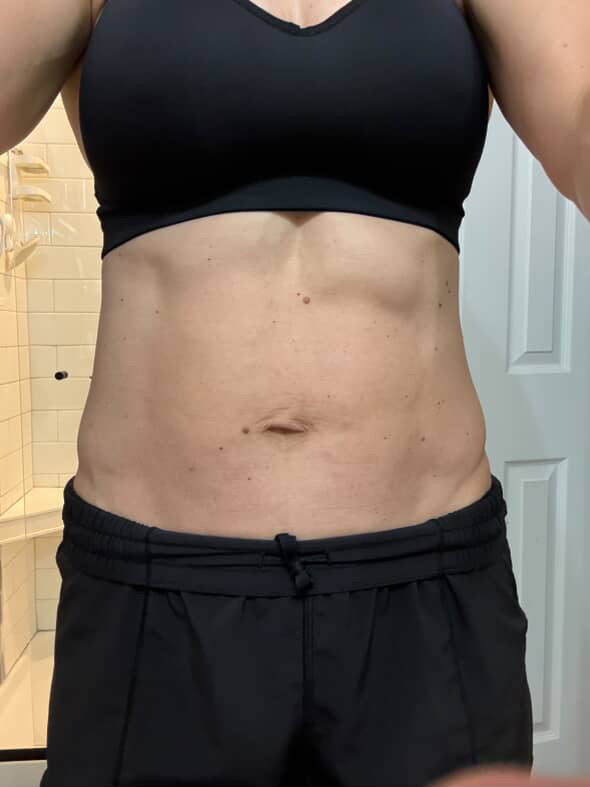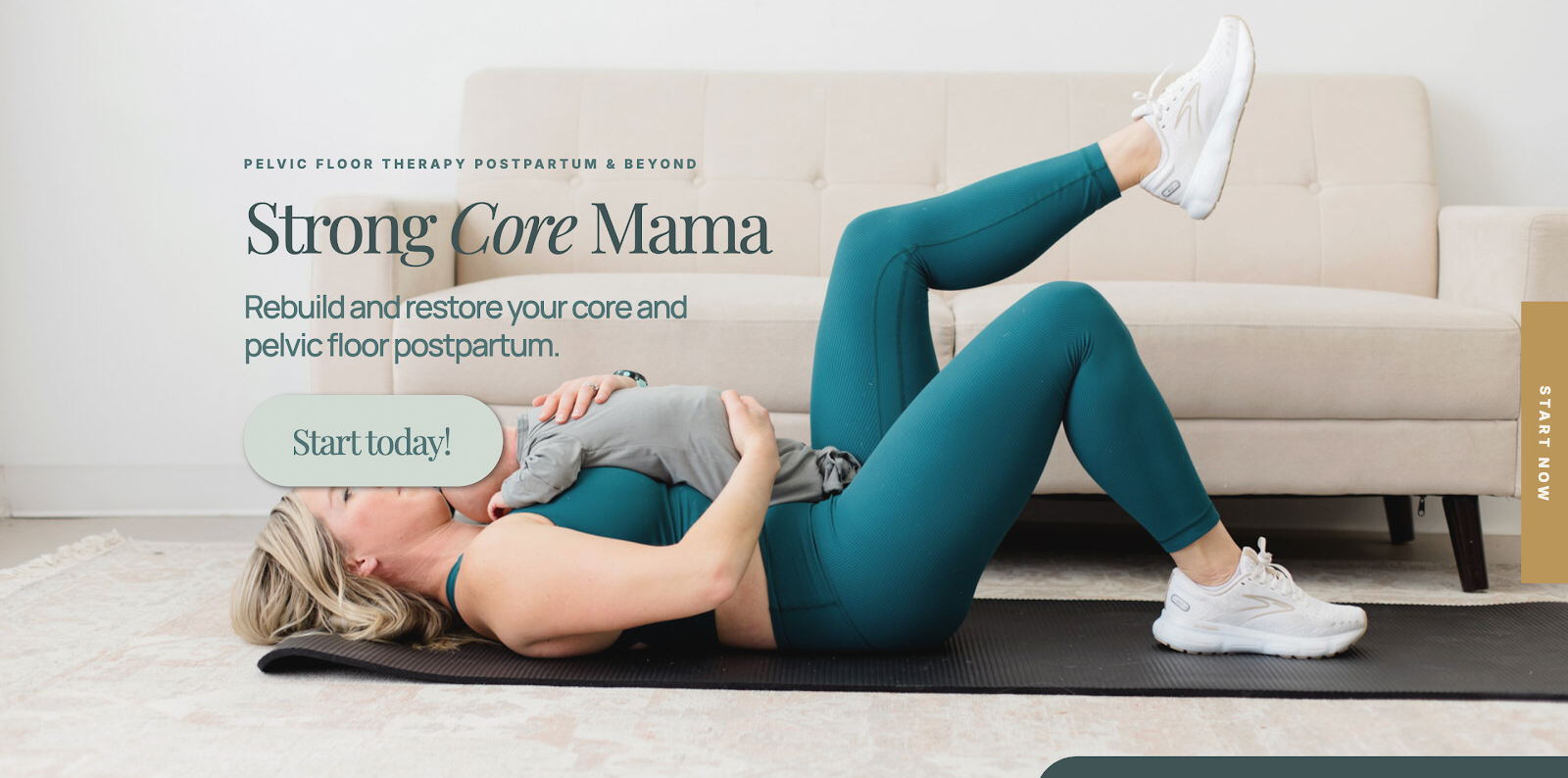If you’ve ever reached for your favorite pre-pregnancy bra, only to realize that it doesn’t fit the same way, you’re not alone. Rib flare postpartum is an issue that I see constantly with the moms I work with as a pelvic floor physical therapist, and I wish more people talked about it!
It’s often a “missing link” that prevents you from healing issues like diastasis recti and other pelvic floor symptoms. Many moms also don’t like the way it looks, but the deeper problem is that it might be contributing to other issues you’re experiencing after having kids.
If you have postpartum rib flare, your ribcage may feel wider than normal, and you may also notice that your ribs stick out more than they used to. This is something you can (and should!) fix, even if you had your kids years ago!
I’ll share a few postpartum rib flare exercises in this blog post to get you started. But first, let’s go over the basics:
What Is Postpartum Rib Flare?
Postpartum rib flare happens when your ribcage gets stuck in an expanded position after pregnancy.
During those nine (or, actually, ten) months, your ribs gradually widened to make room for your growing baby. But sometimes after delivery, they don’t fully return to their original position.
Some moms describe it as feeling like their ribs are “flared out” or “splayed open.” It can make your torso look wider and feel uncomfortable, especially when you’re trying to engage your core muscles or return to activities like running postpartum.


Rib flare isn’t just a visual concern. When your ribs stay in this expanded position, it affects how your core muscles, diaphragm, and pelvic floor muscles all work together.
The BIGGEST reason why it’s important to address rib flare is that your core and pelvic floor can’t heal properly postpartum if your rib cage (and, as a result, your diaphragm) doesn’t resume a normal position.
Lingering rib flare prevents symptoms like diastasis recti, pelvic floor tightness, and peeing when you cough or exercise from healing, EVEN if you’re trying to rehab! Not addressing rib flare is often the “missing link” I see in moms who do pelvic floor PT.
Postpartum Rib Flare Symptoms
Postpartum rib flare is relatively easy to spot if you know what to look for. Essentially, it looks like you have wider ribs. You can also have a one-sided rib flare, such as a left rib flare or a right rib flare, which is when the rib cage expands only on one side of your body.
I also often call it “rib boobs” because the ribs stick out more than your boobs, or just as much so!
Common postpartum rib flare symptoms include:
- Your ribcage visibly protrudes outward, especially the lower ribs
- Bra bands feel tighter around your ribcage
- You feel short of breath or like you can’t take a deep breath
- Your core feels “disconnected” or weak, even when you try to engage it
- You have upper back or lower back tension or pain
- Pelvic floor symptoms and/or diastasis recti that don’t resolve
Rib flare postpartum disrupts your body’s natural breathing mechanics. When your ribs are flared, your diaphragm can’t function optimally, which affects your breathing patterns and core stability.
Your pelvic floor and abdominal muscles work in coordination with your diaphragm, so rib flare can contribute to issues like incontinence, pelvic pressure, or even back and hip pain.
Every year, at least 40 million women worldwide experience long-term health problems after childbirth.
One of the reasons I’m so passionate about the work I do as a pelvic floor PT is that MANY of these issues can be significantly improved, prevented, or completely resolved with proper education and exercises. Rib flare is 100% one of these conditions!
How Do You Tell If You Have a Rib Flare?
The easiest way to check for rib flare is to stand sideways in front of a mirror and look at your profile. Your rib cage resting position should follow a relatively straight line down from your chest.
If your lower ribs stick out noticeably or create an obvious rib cage angle, that’s rib flare.
You can also lie on your back and place your hands on your lower ribs. Take a normal breath. Your ribs should move outward and up slightly as you inhale, then return to their starting position as you exhale. With a rib flare, those ribs often stay in an expanded position.
Is Rib Flare Normal Postpartum?
It depends on how long into postpartum we’re talking about.
Rib flare is normal in early postpartum because of the physical changes that happen during pregnancy. But if your rib flare persists beyond the first few weeks or months, then it’s not normal. Your ribs should go back to normal within a few months.
Beyond early postpartum, rib flare is common, but there’s an important difference between something being “common” and “normal.”
Just because many women experience something doesn’t mean you should accept it or live with it long-term!
Research identifies 83 (!!!) different health problems that women often face after childbirth, such as pelvic floor symptoms, C-section shelf, and other complications. But they’re NOT an inevitable part of motherhood.
How to Fix Rib Flare Postpartum?
Core & pelvic floor physical therapy is the best way to help with proper rib positioning. It includes a few different elements:
Diaphragmatic Breathing (360°)
360-degree breathing is the MOST important thing for rib flare. By that, I mean getting air into the back and side of your rib cage. Most women only know how to breathe in the front of the rib cage, which then contributes to the rib flare.
Learning to breathe into your back and side ribs helps naturally draw your ribs back down and inward to an optimal position.
Diaphragmatic breathing is also essential for healing any pelvic floor dysfunction or symptoms.
Rib Cage Mobility & Posture
Your ribs need to expand when you breathe and then return to a more resting position. However, during pregnancy, many women develop the rib flare, which then leads to decreased rib and spinal mobility.
When your ribs are flared, you don’t have the same amount of spine motion. This can cause tightness and pain in the ribs and spine. Rib and spine mobility exercises help retrain your body and posture, helping restore normal rib movement.
Core & Pelvic Floor Physical Therapy
To fix rib flare, your deep core muscles, diaphragm, and pelvic floor need to work together. Many women try to “suck in” their abs to fix the problem, but this makes it worse. Physical therapy engages your entire body to restore and rebuild your strength & posture.
To fix postpartum rib flare, you need to learn how to do a proper 360-degree breath into your side and back ribs, and you also need to learn how to do a full exhale and drop your ribcage down into a neutral position.
This is something I teach you how to do in my online program, Strong Core Mama.
Postpartum Rib Flare Exercises
These physical therapy exercises help address rib flare:
90/90 Hip Lift with Balloon
4 sets of 5 deep breaths
- Lie on your back with a small ball between your knees and your feet up on a chair
- Position yourself in a slight posterior pelvic tilt (lower back pressed down on the mat, tailbone slightly lifted)
- Take a big inhale through your nose and breathe into your side and back ribs
- As you exhale, blow into a balloon while dropping your ribcage down toward the mat and toward your hips
- Do 5 big breaths, blowing up the balloon, then let the air out and repeat.
Modified Child’s Pose
4 sets of 5 deep breaths
- Place a ball between your knees and move into a modified child’s pose position.
- Rest your elbows against your knees while squeezing the ball.
- Inhale through your nose, focusing on breathing into your sports bra.
- Exhale through your mouth, with your ribs returning to the neutral position.
- Repeat, concentrating on the breath, expanding your ribcage in all directions.
Cross-Body Crunch
2 sets of 5 alternating sides
- Lie on your back on a mat with your right leg extended and your right hand behind your head.
- Inhale through your nose.
- As you exhale, reach your left hand toward your right shin while dropping your right ribcage down toward the mat and your right hip.
- Hold briefly, then slowly return to the starting position.
- Switch sides and repeat.
You can find more evidence-based exercises in my program, Strong Core Mama!

Postpartum Rib Flare and Your Pelvic Floor
Your ribcage and pelvic floor are connected. When your ribs are flared outward, your diaphragm—the large breathing muscle that sits right under your ribs—can’t work the right way.
Your diaphragm and pelvic floor muscles are designed to move together like a “piston”: when you breathe in, both should gently lower, and when you breathe out, both should lift and engage. With a rib flare, this movement gets disrupted.
Your diaphragm stays in a flattened position, which means your pelvic floor loses its main partner in providing core stability.
This is why many moms with rib flare also struggle with core and pelvic floor issues like pelvic floor pain and diastasis recti during postpartum recovery and beyond.
Why Do You Have Flared Ribs Postpartum?
During pregnancy, your body goes through BIG changes to accommodate your growing baby. Your ribcage expands not just to make room, but also because your diaphragm gets pushed upward by your uterus and other internal organs.
This forces your ribs to widen and flare outward so you can breathe properly.
At the same time, your abdominal muscles stretch and often separate (this is called diastasis recti), which changes how your core system functions. These muscles normally help keep your ribs in proper position, but when they’re overstretched, your ribs can stay stuck in the “pregnancy position.”
Plus, with the postural changes that come with carrying a baby, nursing, and the general forward-hunched position of early motherhood, your ribcage often gets locked into a flared rib angle position.
Is Rib Flare Dangerous?
Rib flare isn’t immediately dangerous, but it can contribute to ongoing problems.
When your ribs stay flared upward, it can lead to or worsen issues like incontinence, pelvic pressure, back pain, poor core strength, and other pelvic floor & core symptoms.
It can also make moms feel self-conscious.
In my practice as a pelvic floor physical therapist, I’ve often seen moms do pelvic floor rehab and not see any positive changes because they weren’t addressing their rib flare, and it was preventing issues like diastasis recti from getting better.
Improve Rib Flare & Get Strong with Strong Core Mama
Rib flare can develop during pregnancy and persist for years if you don’t address it. Many moms feel self-conscious about how it looks, but more importantly, it can contribute to core weakness and pelvic floor dysfunction that affects your daily life.
You DON’T have to put up with a rib flare or accept it as just another part of being a mom!
Core & pelvic floor physical therapy can help you get your ribs back in a neutral position and feel strong and confident in your body.
Many women don’t have access to a physical therapist because of time, location, or cost. This is why I created online physical therapy programs like Strong Core Mama.
Inside, you’ll get evidence-based education & exercises that easily fit into your busy life at home. You’ll also get direct access to me to ask questions and get more support!
Learn more & join Strong Core Mama!
